Euthanasia
Last Review Date: May 24, 2021
I. Purpose/Scope
The purpose of this Standard Operating Procedure (SOP) is to outline the procedures on euthanasia and to ensure consistency with the AVMA Guidelines for the Euthanasia of Animals: 2020 Edition. This procedure applies to all personnel involved in the euthanasia of animals involved in research projects sanctioned by The University of Montana Institutional Animal Care and Use Committee (IACUC).
II. Policy
It is LAR policy to meet or exceed all federal, state, and local regulations and guidelines and to comply with all institutional policies and procedures as they apply to the use of animals in research. Personnel must attend any applicable training in animal care and use, occupational health and safety, equipment operation, and Standard Operating Procedures prior to performing activities outlined in this SOP or work under the direct supervision of a trained LAR staff member.
III. Animal Identification
It is the responsibility of the person performing euthanasia to verify accurately the identity of the animal(s) to be euthanatized and to ensure that the principal investigator (PI) or designated animal user has authorized euthanasia. It is imperative to double-check, at a minimum, animal identity before performing euthanasia.
IV. Selection of Specific Agents
The selection of specific agents and methods for euthanasia will depend on the species involved and the objectives of the protocol. Generally, inhalant (non-explosive inhalant anesthetics or CO2) or injectable chemical agents (such as barbiturates) are preferable to physical methods (such as cervical dislocation, decapitation, and use of a penetrating captive bolt). Euthanasia is to be performed by personnel who are skilled in methods for the species in question and in a professional and compassionate manner. Death should be confirmed by personnel who can recognize the cessation of vital signs in the species being euthanatized.
V. Non-Explosive Inhalant, CO2
This method is used for rodents and guinea pigs 600 grams and under.
- Sign-in using the clipboard next to the CO2 unit. Fill out completely including PI name, when you started/ended, number of boxes, and number of animals.
- Place animal to be euthanatized in the chamber, inside its primary enclosure, if possible.
- Fill the euthanasia chamber with CO2 by turning the tank on.
- The regulator has been preset for low-flow volume appropriate to the chamber. DO NOT readjust the brass knob.
- When no movement is detected, turn off CO2
- Remove animal and check for
cessation of vital signs - Use a secondary mechanical means of euthanasia to ensure death (cervical dislocation, decapitation, or creation of pneumothorax).
- When the
animal is confirmed dead, place theanimal in carcass bags (Ziploc bag) and label appropriately (e.g., PI name, strain, wild-type, transgenic, contaminated, etc.) - Discard into LAR
trash cans or appropriate carcass freezer ensuring compliance with NIH disposal guidelines. Refer to the chart.
|
Wildtype (WT) with no drug |
Raptor freezer in HSB |
|
Transgenic (TG)/TG with drug |
Label carcass TG and LAR will dispose of it accordingly (i.e. Incineration)--CannOT go into food chain-- |
|
Contaminated (any drugs used for surgery or injection) |
Place in designated freezer and LAR will dispose of accordingly |
|
Chemically injected carcasses |
Place in designated freezer and LAR will have them picked up by risk management for proper disposal. |
|
BSL-2 |
Autoclave out and then dispose of in LAR trash |
*Appendix M-I-B-1. When an animal covered by Appendix M containing recombinant or synthetic nucleic acid molecules or a recombinant or synthetic nucleic acid molecule-derived organism is euthanized or dies, the carcass shall be disposed of to avoid its use as food for human beings or animals unless food use is specifically authorized by an appropriate Federal agency.
NIH GUIDELINES FOR RESEARCH INVOLVING RECOMBINANT OR SYNTHETIC NUCLEIC ACID MOLECULES (NIH GUIDELINES). DEPARTMENT OF HEALTH AND HUMAN SERVICES. National Institute of Health, Apr. 2019, osp.od.nih.gov/wp-content/uploads/NIH_Guidelines.pdf. p.128.
- Wipe CO2 chamber with Peroxigard spray after use
VI. IP Pentobarbital Euthanasia for Rodents
This method is used for rodents and guinea pigs weighing 600 grams and under.
- Inject animal with an IP overdose of pentobarbital
- Place used needle and syringe in sharps container (do not recap needle)
- When the animal no longer shows any vital signs, use a secondary mechanical means of euthanasia to ensure death (cervical dislocation, decapitation, or creation of pneumothorax).
- When the
animal is confirmed dead, place the animal in carcass bags (Ziploc bag) and label with PI name, strain, gender, etc. - Discard carcasses into the appropriate LAR freezer thus ensuring compliance with NIH disposal guidelines
VII. Injectable Chemical Agents
Chemical agents such as barbiturates are used on larger species such as rabbits, sheep, and non-human primates. Each species requires different dose levels to ensure painless death. It is required that trained personnel perform these procedures, under the direct supervision of the Attending Veterinarian (AV).
- Check with AV for proper dose requirements. Depending on the research protocol, it may be possible to administer a tranquilizer subcutaneously or intramuscularly 10-15 minutes before injection of the euthanasia solution.
- Use the
proper needle and syringe size for the species and drug dose volume - Euthanasia solution may be obtained from the AV or authorized LAR personnel. All doses must be signed out and logged in the controlled substance log book.
- Use an easily identifiable vein for injection
- Place used needle and syringe into a
sharps container (do not recap needle) - When no movement is detected, check for
cessation of breathing andheart beat using a stethoscope - When the
animal is confirmed dead, place the animal in a carcass bag (Ziploc bag) with the PI name, animal strain, gender, ID, and the euthanasia drug used - Place the bag in the appropriate LAR carcass freezer.
